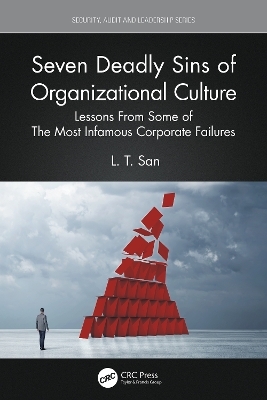
Seven Deadly Sins of Organizational Culture
CRC Press (Verlag)
978-1-032-26547-6 (ISBN)
This book is about the primary symptoms present in a dysfunctional culture that could have devastating outcomes for any organization. The book outlines each of the seven sins in each chapter.
Each of the first seven chapters (Chapters 1–7) starts with a famous quote related to each of the sins and then immediately recounts stories ripped from the headlines describing well-known corporate failures but with a personal touch from former employees who experienced those stories from inside the company. (The sources for these stories are all cited in their Bibliographies).
The seven sins of organizational culture are linked with seven different corporate scandals that serve as a "lesson learned" as well as seven stories of organizations that have been successful with each respective organizational attribute as follows:
Flawed Mission and Misaligned Values uses WorldCom as the lesson learned and Patagonia as the success case
Flawed Incentives uses Wells Fargo as the lesson learned and Bridgeport Financial as the success case
Lack of Accountability uses HSBC as the lesson learned and McDonald’s as the success case
Ineffective Talent Management uses Enron as the lesson learned and Southwest Airlines as the success case
Lack of Transparency uses Theranos as the lesson learned and Zappos as the success case
Ineffective Risk Management uses the 2008 mortgage industry collapse as the lesson learned and Michael Burry as the success case
Ineffective Leadership summarizes all of the foregoing sins as failures of Leadership
In each chapter and for each organizational sin, the author offers seven attributes of a healthy culture to counter the cultural dysfunction. The seven healthy attributes for each of the seven sins are all original content.
In Chapter 8, the author offers an approach for assessing an organization’s culture by providing seven ways to measure the different drivers of organizational culture. The ideas for how to measure corporate culture is original content, with some references to existing frameworks (all cited in the Bibliography),
Finally, in Chapter 9, the author offers a step-by-step outline for transforming the culture. The chapter starts with a story about how Korean Air suffered multiple crashes due to their corporate culture but were able to successfully transform their culture. (The source for the Korean Air story is cited in the Bibliography).
There are seven appendices, most of which are by the author except for the maturity of risk management, which references an OECD (government entity) risk management maturity framework.
Linh S. Truong has extensive experience encompassing 30 years of corporate governance, risk and control frameworks in public accounting as well leadership roles in multiple industries including financial services, oil/gas and healthcare. Ms. Truong obtained a Bachelor of Business Administration and a Master of Business Administration and a Master of Business Administration from the University of Texas at Arlington and Tarleton State University, respectively. She acquired the Certified Public Accountant (CPA), Certified Information Systems Auditor (CISA) and the Certified Internal Controls Auditor (CIA) designations. Ms. Truong has provided executive consulting services to companies ranging from small tech to mid-sized manufacturing firms and Fortune 20 multi-national conglomerates. Ms. Truong’s experience includes positions with KPMG, Credit Suisse Group, Alon USA, Kosmos Energy and Orthofix Medical. As the former Chief Audit Executive at three of her former employers, she established the enterprise risk management initiatives and launched their respective internal audit functions from ground zero. She has also built first year SOX frameworks and brought these efforts in-house from third-party service providers. Her audit career provided her with the opportunity to travel to West and North Africa, Morocco, Brazil, Yemen, and many countries in Europe as well as spend four years in Germany and Switzerland as an expatriate. She is currently the CAE of NTTA (North Texas Tollway Authority) and is responsible for transforming the Internal Audit department as well as launching an Enterprise Risk Management initiative. In this role, she is a member of the executive leadership team reporting administratively to the CEO and functionally to the Board. Prior to joining NTTA, she was an executive consultant and professional speaker who has been invited to speak on the topic of corporate culture at multiple Institute of Internal Audit events and conferences, including the General Audit Management conference in 2019 and the International Conference in 2020. The topics of her speaking engagements also include Fraud/Anti-corruption, Agile Auditing, and Enterprise Risk Management. Her consulting experience include designing and delivering internal audit and risk management training content as well as advising the internal audit team at a Fortune 20 multi-national energy company in their efforts to implement agile auditing. Ms. Truong has authored several articles including Assessing Corporate Culture for the Business Transformation & Operational Excellence Insights Report and Agile Auditing: More Value, Less Resources and Building an Audit Function for the EDP Audit, Control, and Security Newsletter.
Preface. About the Author. Introduction. Chapter 1 Flawed Mission and Misaligned Values. Chapter 2 Flawed Incentives. Chapter 3 Lack of Accountability. Chapter 4 Ineffective Talent Management. Chapter 5 Lack of Transparency. Chapter 6 Ineffective Risk Management. Chapter 7 Ineffective Leadership. Chapter 8 Assessment of Culture. Chapter 9 Culture Transformation. Afterword. Appendix I Healthy Culture Attributes. Appendix II Culture Red Flags. Appendix III OECD ER M Maturity. Appendix IV Culture Assessment Survey. Appendix V Culture Wellness Report Card. Appendix VI Culture Assessment Attributes. Appendix VII Common Categories of Root Causes. Index.
| Erscheinungsdatum | 27.10.2023 |
|---|---|
| Reihe/Serie | Security, Audit and Leadership Series |
| Zusatzinfo | 9 Tables, black and white |
| Verlagsort | London |
| Sprache | englisch |
| Maße | 156 x 234 mm |
| Gewicht | 263 g |
| Themenwelt | Mathematik / Informatik ► Informatik ► Theorie / Studium |
| Recht / Steuern ► Privatrecht / Bürgerliches Recht ► IT-Recht | |
| Wirtschaft ► Betriebswirtschaft / Management ► Planung / Organisation | |
| Wirtschaft ► Volkswirtschaftslehre | |
| ISBN-10 | 1-032-26547-7 / 1032265477 |
| ISBN-13 | 978-1-032-26547-6 / 9781032265476 |
| Zustand | Neuware |
| Informationen gemäß Produktsicherheitsverordnung (GPSR) | |
| Haben Sie eine Frage zum Produkt? |
aus dem Bereich


